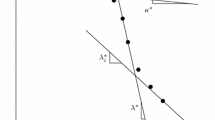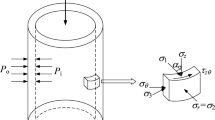Abstract
A mathematical framework for the description of structureless clay behaviour is proposed in this paper. It is based on the observation that there exists a biunique relationship between the radial stress path direction and the compression curve on the specific volume (v = 1 + e)—mean effective stress (σ or p) plane. The projection on the v − σ plane defines the Intrinsic Compression Curve (ICC) of the corresponding radial stress path, which results in infinite possible ICC curves. Following a normalization procedure, a general methodology is presented, which can be applied to any mathematical formulation of the ICC curve. The constants included in this description are called intrinsic properties. This procedure can be easily implemented to anisotropic constitutive models. Its importance is based on the fact that modern constitutive models require a definition of the structureless state, as this state is the limiting reference state of the fully destructured material. In addition, the paper presents a set of correlations for the estimation of the intrinsic properties from the index properties, which helps on the preliminary selection of the material constants.


















Similar content being viewed by others
Notes
The subscript η stands for the dependence of the ICC on the radial stress path.
Abbreviations
- ε q :
-
Axisymmetric deviatoric strain
- ε v :
-
Volumetric strain
- η :
-
Stress ratio tensor
- ησ :
-
Tensorial stress ratio
- η q :
-
Axisymmetric stress ratio
- λ:
-
Intrinsic Compressibility
- σ :
-
Stress tensor
- σ ij :
-
Stress tensor
- σ:
-
Mean or isotropic effective stress
- σ v :
-
Vertical effective stress
- CSC :
-
Critical State Curve
- CSE :
-
Critical State Envelope
- c u :
-
Undrained shear strength
- d q :
-
Axisymmetric dilatancy
- e :
-
Voids’ ratio
- I :
-
Unit tensor
- ICC :
-
Intrinsic Compression Curve
- ICC :
-
Intrinsic Compressibility Envelope
- K :
-
Earth pressure coefficient
- M :
-
Critical slope
- N η :
-
Position of ICC
- p :
-
Mean or isotropic effective stress
- s :
-
Deviatoric stress tensor
- v :
-
Specific volume
References
Allman MA, Atkinson JH (1992) Mechanical properties of reconstituted Bothekennar soil. Géotechnique 42(2):289–301
Amorosi A, Rampello S (2007) An experimental investigation on the mechanical behaviour of a structured stiff clay. Géotechnique 57(2):153–166
Amorosi A, Callisto L, Rampello S (1999) Observed behaviour of reconstituted clay along stress paths typical of excavations. Pre-fail Deform Char Geomat 2:35–42
Banerjee PK, Stipho AS, Yousif NB (1984) Chapter 1: a theoretical and experimental investigation of the behaviour of anisotropically consolidated clay. In: Banerjee PK, Butterfield R (eds) Developments in soil mechanics and foundation engineering, vol II. Elsevier Appl Sci, London, pp 1–41
Belokas G (2008) Modelling of the mechanical behaviour of structured and anisotropic soil materials. PhD thesis. National Technical University of Athens, p 695 (in Greek)
Belokas G, Kavvadas M (2010) An anisotropic model for structured soils part I: theory. Comput Geotec 37(6):737–747
Belokas G, Kavvadas M, Amorosi A (2005) Modelling the behaviour of reconstituted soils under radial stress paths. In: Barla G, Barla M (eds) Proceedings 11th international conference on computer methods and advances in geomechanics (IACMAG), vol 1. Torino, Italy, pp 249–256
Bishop AW, Eldin AKG (1953) The effect of stress history on the relation between φ and porosity in sand. In: Proceedings of the third international conference on soil mechanics and foundation engineering, vol 1. pp 100–105
Broms B, Ratnam MV (1963) Shear strength of an anisotropically consolidated clay. J Soil Mech Found Div ASCESM 6:1–26
Burland JB (1990) On the compressibility and shear strength of natural clays. Géotechnique 40(3):329–378
Cafaro F, Cotecchia F (2001) Structure degradation and changes in the mechanical behaviour of a stiff clay due to weathering. Géotechnique 51(5):441–453
Canestrari F, Scarpelli G (1993) Stress-dilatancy and strength of Ancona clay. In: Proceedings of international symposium on the geotechnical engineering of hard soils—soft rocks in Athens, vol 1. Balkema, Rotterdam, pp 417–424
Cecconi M, Viggiani G, Rampello S (1998) An experimental investigation of the mechanical behaviour of a pyroclastic soft rock. In: Proceedings of 2nd international symposium on the geomechanics of hard soils—soft rocks in Napoli, vol 1. Balkema, Rotterdam, pp 473–482
Chandler RJ (2000) Clay sediments in depositional basins: the geotechnical cycle. The 3rd glossop lecture. Quart J Eng Geol Hydrogeol 33:9–39
Coop MR (1990) The mechanics of uncemented carbonate sands. Géotechnique 40(4):607–626
Coop MR, Atkinson JH (1993) The mechanics of cemented carbonate sands. Géotechnique 43(1):53–67
Cotecchia F, Chandler RJ (1997) The influence of structure on the pre-failure behaviour of a natural clay. Géotechnique 47(3):523–544
Cotecchia F, Cafaro F, Aresta B (2007) Structure and mechanical response of sub-Apennine blue clays in relation to their geological and recent loading history. Symposium in print: stiff sedimentary clays—genesis and engineering behaviour: part 2. Géotecnique 57(2):167–180
Dafalias YF (1987) An anisotropic critical state clay plasticity model. In: Desai M et al. (ed) 2nd International conference on constitutive laws for engineering materials. Theory and applications, vol 1. Tucson, Arizona, pp 513–521
Donaghe RT, Townshed FC (1978) Effects of anisotropic versus isotropic consolidation in consolidated-undrainded triaxial compression tests of cohesive soils. Geotech Test J 1(4):173–189
d’Onofrio A, de Magistris FS, Olivares L (1998) Influence of soil structure behaviour of two natural stiff clays in the pre-failure range. In: Proceedings of 2nd International symposium on the geotechnics of hard soils—soft rocks in Napoli, vol 1. Balkema, Rotterdam, pp 497–505
Gajo A, Wood DM (2001) A new approach to anisotropic, bounding surface plasticity: general formulation and simulations of natural and reconstituted clay behaviour. Int J Num Anal Method Geomech 25:207–241
Gens A (1982) Stress-strain and strength of a low plasticity clay. PhD thesis. Imperial College of Science, Technology and Medicine. University of London
Gens A, Potts DM (1982) Application of critical state soil models to the prediction of the behaviour of a normally consolidated low plasticity clay. In: International symposium on numerical models in geomechanics in Zurich. pp 312–323
Georgiannou VN (1988) The behaviour of clayey sands under monotonic and cyclic loading. PhD thesis. Imperial College of Science, Technology and Medicine. University of London
Kavvadas M (1995) A plasticity approach to the mechanical behaviour of bonded soils. In: Proceedings of 4th international conference on computational plasticity (COMPLAS IV), Barcelona
Kavvadas M (1998) Hard soils—soft rocks: modelling the soil behaviour—selection of soil parameters, general report. In: Proceedings 2nd international symposium on the geotechnics of hard soils—soft rock in Napoli, vol 3. Balkema, Rotterdam, pp 1441–1482
Kavvadas M, Amorosi A (2000) A constitutive model for structured soils. Géotechnique 50(1):263–273
Kavvadas M, Anagnostopoulos A (1998) A framework for the mechanical behaviour of structured soils. In: Proceedings 2nd international symposium on the geotechnics of hard soils—soft rocks in Napoli, vol 2. Balkema, Rotterdam, pp 591–601
Kavvadas MJ, Belokas G (2001) An anisotropic elastoplastic constitutive model for natural soils. In: Proceedings of 10th international conference on computer methods and advances in geomechanics (IACMAG), vol 1. Tucson, Arizona, pp 335–340
Koninis GE, Tika TM, Kallioglou PA, Sarigiannis D (2001) The influence of the structure of natural clay material on their compressibility. Proceedings of 4th panhellenic conference of geotechnical and geoenvironmental engineering, in Athens, vol 1. pp 81–88 (in Greek)
Lehane B, Faulkner A (1998) Stiffness and strength characteristics of a hard lodgement till. In: Proceedings of 2nd international symposium on the geotechnics of hard soils—soft rocks in Napoli, vol 2. Balkema. Rotterdam, pp 637–646
Leroueil S, Vaughan PR (1990) The general and congruent effects of structure in natural soils and weak rocks Géotechnique 40(3):467–488
Lewin PI, Burland JB (1970) Stress-probe experiments on saturated normally consolidated clay Géotechnique 20(1):38–56
Mitchell JK (1992) Fundamentals of soil behavior, 2nd edn. Wiley, New York, p 437
Pender MJ (1978) A model for the behaviour of over consolidated soil. Géotechnique 28(1):1–25
Rampello S, Silvestri F (1993) The stress-strain behaviour of natural and reconstituted samples of two over consolidated clays. In: Proceedings of international symposium on the geotechnical engineering of hard soils—soft rocks in Athens, vol 1. Balkema, Rotterdam, pp 769–778
Rampello S, Viggiani G, Georgiannou VN (1993) Strength and dilatancy of natural and reconstituted Vallericca clay. In: Proceedings of international symposium on the geotechnical engineering of hard soils—soft rocks, in Athens, vol 1. Rotterdam, Balkema, pp 761–768
Rampello S, Viggiani GMB, Amorosi A (1997) Small-strain stiffness of reconstituted clay compressed along constant triaxial effective stress ratio paths. Géotechnique 47(3):475–489
Roscoe KH, Schofield AN, Wroth CP (1963) On the yielding of soils. Géotechnique 8(1):22–52
Santucci de Magistris F, Tatsuoka F, Sato T, Koseki J (1998) Effects of strain rate and ageing on small strain behaviour of a compacted silty sand. In: proceedings of international symposium on the geotechnics of hard soils—soft rocks, in Napoli, vol 2. Rotterdam, Balkema, pp 843–854
Stipho AS (1982) Extended critical state model for anisotropically consolidated clays. In: International symposium on numerical methods in geomechanics in Zurich, pp 183–188
Terzaghi K, Peck RB, Mesri G (1996) Soil mechanics in engineering practice, 3rd edn. Wiley, New York, p 549
Vaughan PR (1988) Characterising the mechanical properties of in situ residual soil. In: Proceedings of 2nd international conference geomechanics in tropical soils, vol 2. Singapore, pp 469–487
Wood DM (1990) Soil behaviour and critical state soil mechanics. Cambridge University Press, Cambridge
Wood DM (1995) Kinematic hardening model for structured soil. In: Proceedings of international symposium on numerical models in geomechanics (NUMOG V), Davos, Balkema, pp 83–88
Acknowledgments
The authors wish to thank the reviewers for their constructive comments, which helped us to improve the manuscript.
Author information
Authors and Affiliations
Corresponding author
Rights and permissions
About this article
Cite this article
Belokas, G., Kavvadas, M. An Intrinsic Compressibility Framework for Clayey Soils. Geotech Geol Eng 29, 855–871 (2011). https://doi.org/10.1007/s10706-011-9422-0
Received:
Accepted:
Published:
Issue Date:
DOI: https://doi.org/10.1007/s10706-011-9422-0




